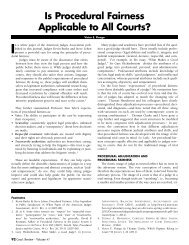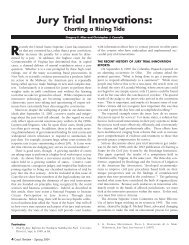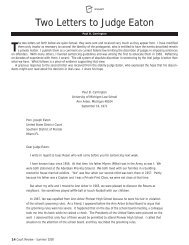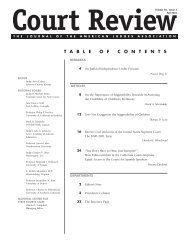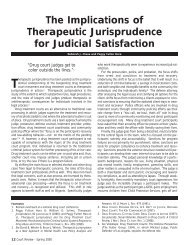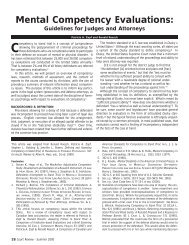Special Issue on Procedural Fairness - American Judges Association
Special Issue on Procedural Fairness - American Judges Association
Special Issue on Procedural Fairness - American Judges Association
- No tags were found...
You also want an ePaper? Increase the reach of your titles
YUMPU automatically turns print PDFs into web optimized ePapers that Google loves.
dural justice can obscure the equally important issue of distributivejustice. The c<strong>on</strong>cern with how best to allocateresources or outcomes has a l<strong>on</strong>g history, dating back at leastas far as Aristotle, 7 and modern work <strong>on</strong> distributive justice—from both theoretical and experimental perspectives—c<strong>on</strong>tinuesunabated. 8 Without denying the benefits to be gained fromimproving procedural justice, <strong>on</strong>e could even argue that c<strong>on</strong>cernsabout distributive justice should be paramount.Questi<strong>on</strong>s about process are, in a sense, c<strong>on</strong>tingent <strong>on</strong> questi<strong>on</strong>sabout outcome. Unless some outcome occurs, the proceduresused to arrive at that outcome are moot. 9 Thus, weshould not lose sight of what courts can do to enhance percepti<strong>on</strong>sof distributive fairness, in additi<strong>on</strong> to enhancing percepti<strong>on</strong>sof procedural fairness.OUTCOME VERSUS PROCESS IN THE COURTSThe outcomes that occur to citizens from acti<strong>on</strong>s by the justicesystem can be, and often are, life-altering: loss of liberty,life, or reputati<strong>on</strong>; compelled or prohibited behaviors; transferof substantial sums of m<strong>on</strong>ey. One can c<strong>on</strong>strue these outcomesas a distributi<strong>on</strong> of punishment and/or rewards to theaffected parties. Courtroom procedures, for their part, are foreignand time-c<strong>on</strong>suming at best, and terrifying at worst. Inlight of the high stakes, it would seem to be a “no-brainer” forjudges and other court pers<strong>on</strong>nel to make the procedures asfair and “user-friendly” as possible, for litigants as well as otheraffected parties (e.g., witnesses, jurors). 10 Significantly, judgeshave more leeway in the procedures they use than in the outcomesthey deliver, which are c<strong>on</strong>strained by evidentiaryguidelines, legal precedent, sentencing guidelines, and thespectre of appellate review, am<strong>on</strong>g other factors.Perhaps because of these c<strong>on</strong>straints, “judges focus <strong>on</strong> thefairness of case outcomes instead of the process.” 11 The problemhere is not that judges focus <strong>on</strong> outcomes more thanprocesses, but that they focus <strong>on</strong> outcomes largely to the exclusi<strong>on</strong>of processes. A simple thought experiment illustrates thedesirability of focusing <strong>on</strong> outcomes more than processes.Suppose that Defendant A and Defendant B have both beencharged with first-degree murder, a crime that they did notcommit. They are tried separately, in the same courtroom andwith the same evidence. In Defendant A’s trial, he is notallowed to testify, the judge shows clear favoritism to the prosecutor,and court pers<strong>on</strong>nel treat A in a rude and c<strong>on</strong>descendingmanner. N<strong>on</strong>etheless, the jury acquits. In Defendant B’strial, he is allowed to addressthe court, the judge is scrupulouslyimpartial, and court pers<strong>on</strong>nelare extremely solicitousand respectful. N<strong>on</strong>etheless,the jury c<strong>on</strong>victs. Clearly, theprocess in B’s trial is more fair,and any<strong>on</strong>e would prefer the Bcourt’s procedures. But <strong>on</strong> thewhole (taking distributive andprocedural c<strong>on</strong>cerns together),which situati<strong>on</strong> is better?The c<strong>on</strong>cern withhow best toallocate resourcesor outcomes hasa l<strong>on</strong>g history,dating back atleast as far asAristotle....Would you rather be Defendant A or Defendant B? A’s situati<strong>on</strong>seems better from a societal perspective, because the courtreached the right outcome, albeit by suboptimal procedures.Moreover, most, if not all, people would choose to beDefendant A rather than Defendant B. In this situati<strong>on</strong>, outcometrumps process.Now suppose the hypothetical is the same, except that Aand B did, in fact, commit the crime. What then? Again, most,if not all, people would choose to trade places with DefendantA, even though, from a societal perspective, a murderer hasbeen set free. The manner of B’s trial might provide him somec<strong>on</strong>solati<strong>on</strong>, but it is likely to offer him <strong>on</strong>ly small comfort. Ofcourse, in more ambiguous cases, outcome would not necessarilytrump process; and as Burke and Leben describe, a fairprocess can go a l<strong>on</strong>g way toward softening a harsh outcome.Similarly, an unfair process can make a positive outcome lesssatisfying. But pushed to the extremes, outcome matters morethan process.PRINCIPLES OF DISTRIBUTIVE JUSTICEAs menti<strong>on</strong>ed above, judges’ allocati<strong>on</strong> of outcomes is c<strong>on</strong>strainedby a variety of factors. N<strong>on</strong>etheless, except wheremandatory sentencing guidelines apply, criminal judges retaina fair degree of discreti<strong>on</strong>, and civil judges also have c<strong>on</strong>siderableflexibility in fashi<strong>on</strong>ing a remedy, in terms of both the typeof remedy (e.g., m<strong>on</strong>etary vs. other restituti<strong>on</strong>) and theamount. In allocating some resource, decisi<strong>on</strong> makers can rely<strong>on</strong> several different principles of distributive justice. Whenjudges mete out punishment (in criminal cases) or redistributem<strong>on</strong>ey (in civil cases), it behooves them to be sensitive to thevarious principles that could be applied, and the different goalsthat those principles serve.7. See, e.g., MILLER, supra note 4; John T. Scott et al., Just Deserts: AnExperimental Study of Distributive Justice Norms, 45 AMER. J. POL.SCI. 749, 750-51 (2001).8. See, e.g., MORTON DEUTSCH, DISTRIBUTIVE JUSTICE (1985); NORMANFROHLICH & JOE A. OPPENHEIMER, CHOOSING JUSTICE: ANEXPERIMENTAL APPROACH TO ETHICAL THEORY (1992); MELLERS &BARON, supra note 4; JOHN RAWLS, A THEORY OF JUSTICE (1971);Philip Michelbach et al., Doing Rawls Justice: An ExperimentalStudy of Income Distributi<strong>on</strong> Norms, 47 AMER. J. POL. SCI. 528(2003); Scott et al., supra note 7.9. In some circumstances, the failure to reach an outcome is the outcome.This happens, for example, when there is a hung jury, whena law firm postp<strong>on</strong>es a decisi<strong>on</strong> about making a junior associate apartner, or when a university places an applicant <strong>on</strong> a waiting list.Because these “n<strong>on</strong>-decisi<strong>on</strong>s” n<strong>on</strong>etheless carry c<strong>on</strong>sequencesfor those involved (e.g., the defendant still can be retried, theassociate still does not share in the firm’s profits, the applicant stilldoes not have a university to attend), they functi<strong>on</strong> as unique outcomesand therefore do not change the analysis.10. For a review of some of the procedural innovati<strong>on</strong>s that have beentried, especially with jurors, see M<strong>on</strong>ica K. Miller & Brian H.Bornstein, Juror Stress: Causes and Interventi<strong>on</strong>s, 30 T. MARSHALL L.REV. 237 (2004).11. Burke & Leben, supra note 1, at 14.Court Review - Volume 44 73




